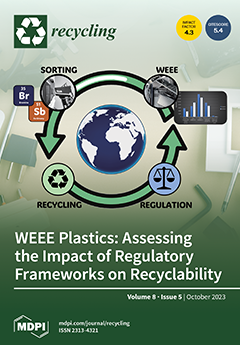In many Indian regions, increased wastewater is both a threat to public health and the environment, but it also presents an opportunity as a source of water and nutrients. With less than one-third of India’s wastewater treated and an alarming water scarcity situation,
[...] Read more.
In many Indian regions, increased wastewater is both a threat to public health and the environment, but it also presents an opportunity as a source of water and nutrients. With less than one-third of India’s wastewater treated and an alarming water scarcity situation, efficient wastewater treatment and reuse schemes are needed to face impending water and fertiliser shortages. This study explores the application potential of wastewater fertigated Short Rotation Coppice systems (wfSRC) as a cost-efficient and promising solution for treating and reusing wastewater in a specific region (400 km
2, 184 settlements) of Aligarh (UP), India. Based on real data from a local wfSRC pilot site using bamboo, willow, and poplar, we analysed the system’s treatment performance, nutrient recovery, carbon sequestration potential, land requirements, biomass production potential, and cost–benefit, under various scenarios. The results show that the pilot wfSRC system is efficiently treating 250 m
3/day of domestic wastewater on 6864 m
2 of land, and serving 2500 people. The land requirements for wfSRC systems vary depending on local conditions (e.g., climate, soil type, wastewater composition) and user demands (e.g., water reuse efficiency, type, and amount of biomass). The calculated areas ranged from 2.75 to 25.7 m
2/PE, which equates to a required land area in the whole study region of between 108 and 1006 ha in 2036. This would produce up to 100 DM t/ha/year of valuable biomass. Early local stakeholder involvement and the monitoring of pollutants are recommended as priorities during the planning process for the large-scale implementation of wfSRC systems in India.
Full article





